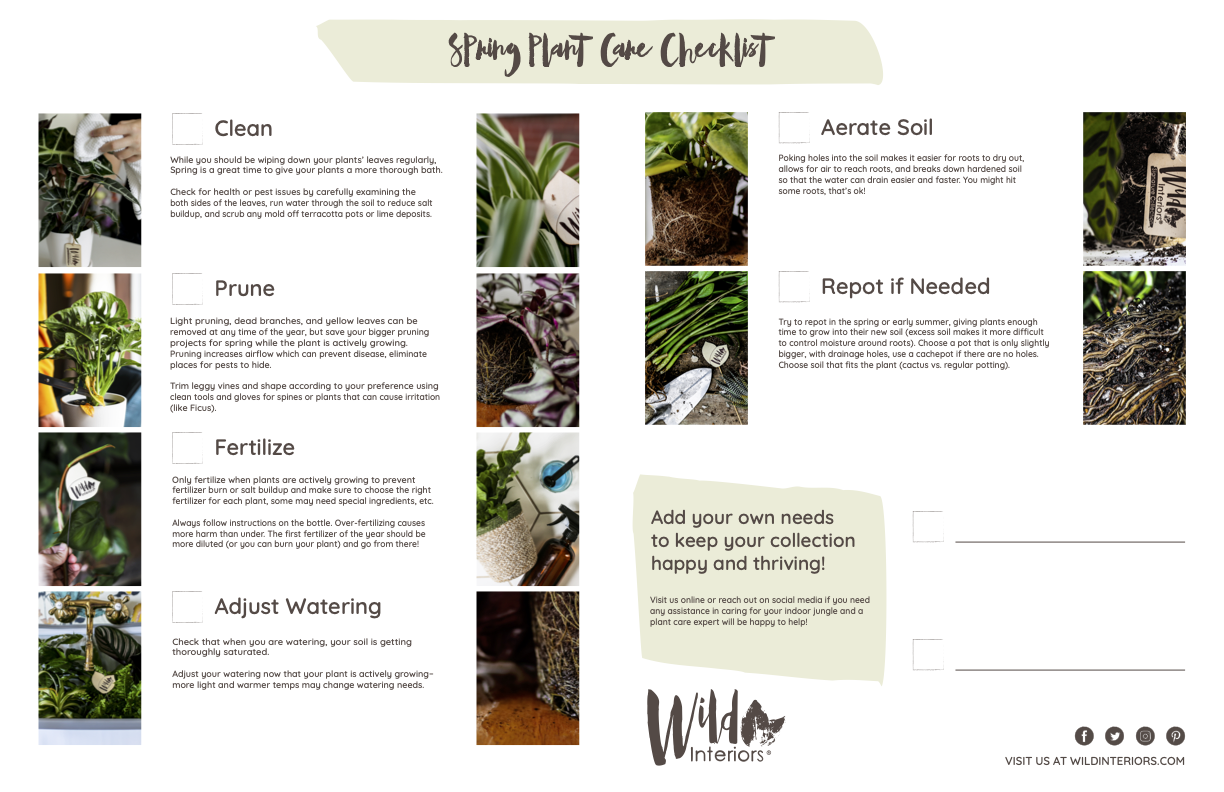Spring Houseplant Checklist (FREE Download Included)
Spring is here and we know that our houseplants are just as excited as we are for the new season and warmer temps! Just like us, our houseplants go through a slowdown over the fall and winter months. While for us that may have meant more relaxing on the couch and binge-watching our favorite shows, our plants go through a literal slowdown where their systems enter a period of rest or dormancy.
During this time our plants do not experience much, if any growth. But as the daylight hours lengthen and the temperatures warm, our plants awaken to a new spring season of growth. If you haven’t noticed new sprouts and shoots on your houseplants, look! As our plants enter this time of change, there are some special care tips to follow that will promote healthy growth this spring! We’ve created a Spring Houseplant Checklist that you can print and have on hand as you take care of the special needs of your houseplants this season. Hopefully, this inspires you year after year to give your plants what they need each season.
Spring Houseplant Checklist
✔️ Clean
While you should wipe down the leaves on your plants regularly, spring is a great time to renew these efforts and give them a more thorough bath. Paying closer attention to your plants allows you to check for any health or pest issues you may not notice on a regular day or when you are just giving them some water. Wipe down the tops and bottoms of the leaves. Removing dust and any debris that may have settled on your plants' leaves allows them to better photosynthesize, which means better growth! This is also a good time to run water through your plants’ soil to reduce salt buildup. You can scrub any mold or lime deposits off terracotta pots and clean your houseplants' surroundings. A little spring cleaning for your houseplants will go a long way in supporting healthy growth!
✔️ Prune
Light pruning and the removal of dead branches or yellow leaves can be done at any time of the year but save your bigger pruning projects for spring while the plant is actively growing. Shape your houseplants' foliage according to your preference and trim leggy vines. Use clean, sterilized tools for pruning, and take care to wear gloves for plants with spines or ones that can cause irritation (like Ficus).
Pruning helps your plant conserve energy that is being sent to dying or damaged leaves so that it can be directed to support new growth instead. Pruning also increases airflow which can prevent disease and eliminate places for pests to hide. While it can be painful to trim away at your plants, it’s all for a good cause to help foster new growth in the long run!
✔️ Fertilize
It is best to only fertilize houseplants during the spring and summer months when your plants are actively growing, so try to avoid this in the cooler seasons unless you live in an extremely warm climate. This will help to prevent fertilizer burn or salt buildup.
When fertilizing, always follow the instructions on the bottle. Over-fertilizing causes more harm than under-fertilizing. The first fertilization of the year should be more diluted to not accidentally burn your plants, you can then ramp up slowly to a normal fertilizing routine. Choose the right fertilizer for each plant, some need special ingredients or nutrients. Also, don’t water your plants the same week you fertilize them, as it would be too much moisture for them to handle.
✔️ Adjust Watering
Any change in season may bring changes to the watering needs of your houseplants. Factors such as hours of daylight, temperature, and proximity to indoor heating or cooling elements can affect the amount of moisture your indoor plants need. Now that your plant is actively growing, it will require more water. Check that when you are watering, your soil is getting thoroughly saturated and you’re removing any excess water that has drained down into your outer pot.
A reminder that it is better to underwater your plants than overwater them, which can lead to root rot. If you aren’t sure if your plants are getting enough or too much, be cautious and slowly ramp up the watering as the temperatures get warmer.
Are there any steps on your spring plant care routine that you don’t see on this list? We’d love to hear, send us a note at @wild_interiors on IG.


